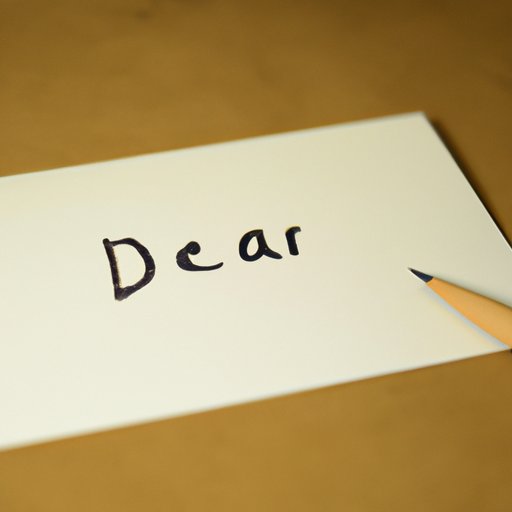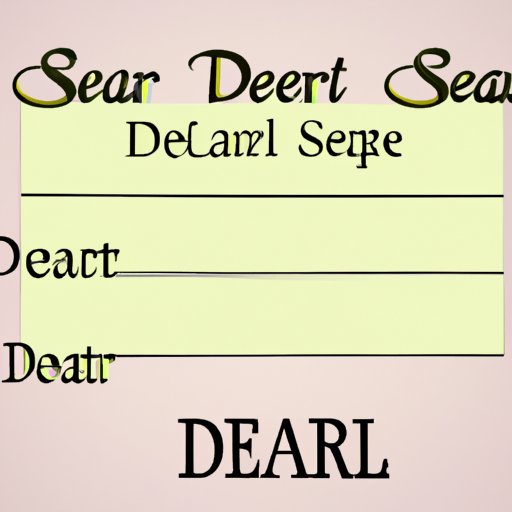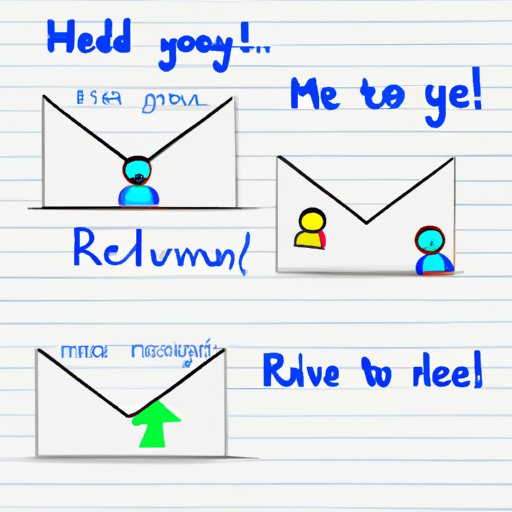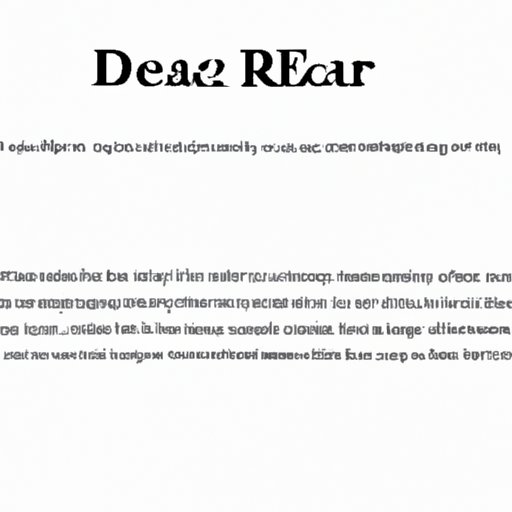Introduction
When writing a letter, it is important to start off on the right foot by using a polite and friendly salutation. One of the most popular ways to begin a letter is to use the word “Dear.” But what does this mean exactly? And how should you use it when addressing someone? This article will explore the definition of “Dear” and its purpose for starting a letter, as well as provide tips, guidelines, and examples for using it appropriately.
Definition of “Dear”
The term “Dear” is used as a form of address or salutation at the beginning of a letter or email. It is typically used when writing to someone with whom you have a close relationship, such as family, friends, or colleagues. The word “Dear” expresses warmth and familiarity, and is often seen as a way to show respect and politeness.

Purpose of Starting a Letter with “Dear”
Starting a letter with “Dear” is a common practice that adds a personal touch. It sets the tone for the rest of the letter, conveying a sense of politeness and friendliness. By using the word “Dear” to address someone, you are expressing your respect for them and showing a level of care and consideration for their feelings. Additionally, using “Dear” can help to create a more informal atmosphere, which can be beneficial if you are trying to build a connection with the recipient.
Tips for Choosing the Right Salutation for Your Letter
When starting a letter with “Dear,” there are a few things to keep in mind to ensure that you are using the word correctly. Here are some tips for choosing the right salutation for your letter:
Consider the Relationship Between You and the Recipient
When using “Dear” to address someone, it is important to consider the relationship between you and the recipient. For example, if you are writing to a close friend or family member, you may want to use a more casual salutation such as “Hi” or “Hello.” On the other hand, if you are writing to someone you do not know very well, or who is in a position of authority, it is best to stick with the more formal “Dear.”
Research the Person’s Preferred Title
If you are writing to someone in a professional setting, it is important to research their preferred title. For example, if you are writing to a doctor, you may want to address them as “Dr. [Last Name]” instead of simply “Dear [First Name].” Doing your research beforehand will ensure that you are using the correct title and showing the proper respect to the recipient.
Use Gender-Neutral Language
When addressing someone in a letter, it is important to use gender-neutral language. Instead of using “Mr.” or “Mrs.,” opt for a gender-neutral term such as “Mx.” or “Ms.” This will show the recipient that you are respectful of their identity and open to all types of people.

Guidelines for Writing Professional Letters with “Dear”
When writing a professional letter, it is important to follow certain guidelines to ensure that you are conveying the right message. Here are some tips for writing professional letters with “Dear”:
Keep the Greeting Short and to the Point
When writing a professional letter, it is best to keep the greeting short and to the point. Avoid adding any unnecessary words or phrases, as this can make the letter seem overly long and unprofessional. Stick to using just “Dear” followed by the recipient’s name.
Make the Salutation Specific to the Recipient
When addressing someone in a professional letter, it is important to make the salutation specific to the recipient. For example, if you are writing to a doctor, you may want to address them as “Dr. [Last Name]” instead of “Dear [First Name].” This will show the recipient that you have taken the time to research their title and are taking the letter seriously.
Crafting an Appropriate Greeting When Writing to Someone You Don’t Know
When writing to someone you don’t know, it can be difficult to craft an appropriate greeting. Here are some tips for crafting an appropriate greeting when writing to someone you don’t know:
Use a Formal Address
When writing to someone you don’t know, it is best to use a formal address such as “Dear Sir/Madam” or “To Whom It May Concern.” This will show the recipient that you are being respectful and taking the letter seriously.
Include the Recipient’s Name and Title
If you know the recipient’s name and title, it is best to include both in the salutation. For example, if you are writing to a doctor, you may want to address them as “Dr. [Last Name].” This will show the recipient that you have done your research and are taking the letter seriously.
Do Not Assume Gender
When writing to someone you don’t know, it is important not to assume their gender. Instead of using terms such as “Mr.” or “Mrs.,” opt for gender-neutral terms such as “Mx.” or “Ms.” This will show the recipient that you are respectful of their identity and open to all types of people.

Examples of Different Ways to Greet Someone in a Letter
Now that we have discussed the basics of starting a letter with “Dear,” let’s take a look at some examples of different ways to greet someone in a letter:
Examples for Friends and Family
For friends and family, you may want to use a more casual salutation such as “Hi [Name],” “Hello [Name],” or “Dear [Name].” This will show the recipient that you are familiar with them and that you care about them.
Examples for Business Associates
For business associates, it is best to use a more formal salutation such as “Dear [Title] [Last Name],” “Dear [First Name],” or “Dear [Title] [First Name].” This will show the recipient that you are taking the letter seriously and that you respect their title and position.
Examples for Unknown Recipients
For unknown recipients, it is best to use a more formal salutation such as “Dear Sir/Madam,” “To Whom It May Concern,” or “Dear [Company Name].” This will show the recipient that you are taking the letter seriously and that you are respectful of their time.
Conclusion
Starting a letter with “Dear” is a common practice that adds a personal touch. This article has provided tips on choosing the right salutation, writing professional letters, crafting an appropriate greeting for unknown recipients, and includes examples of different ways to greet someone in a letter. By following these tips and guidelines, you can ensure that you are using the word “Dear” correctly and making a good impression on the recipient.
(Note: Is this article not meeting your expectations? Do you have knowledge or insights to share? Unlock new opportunities and expand your reach by joining our authors team. Click Registration to join us and share your expertise with our readers.)
